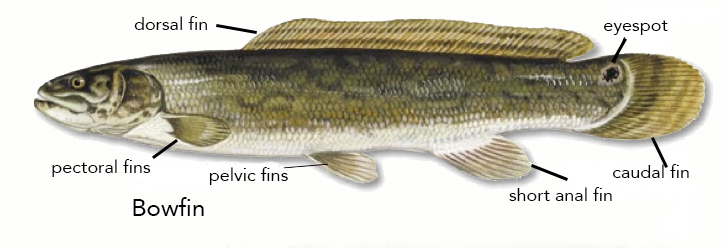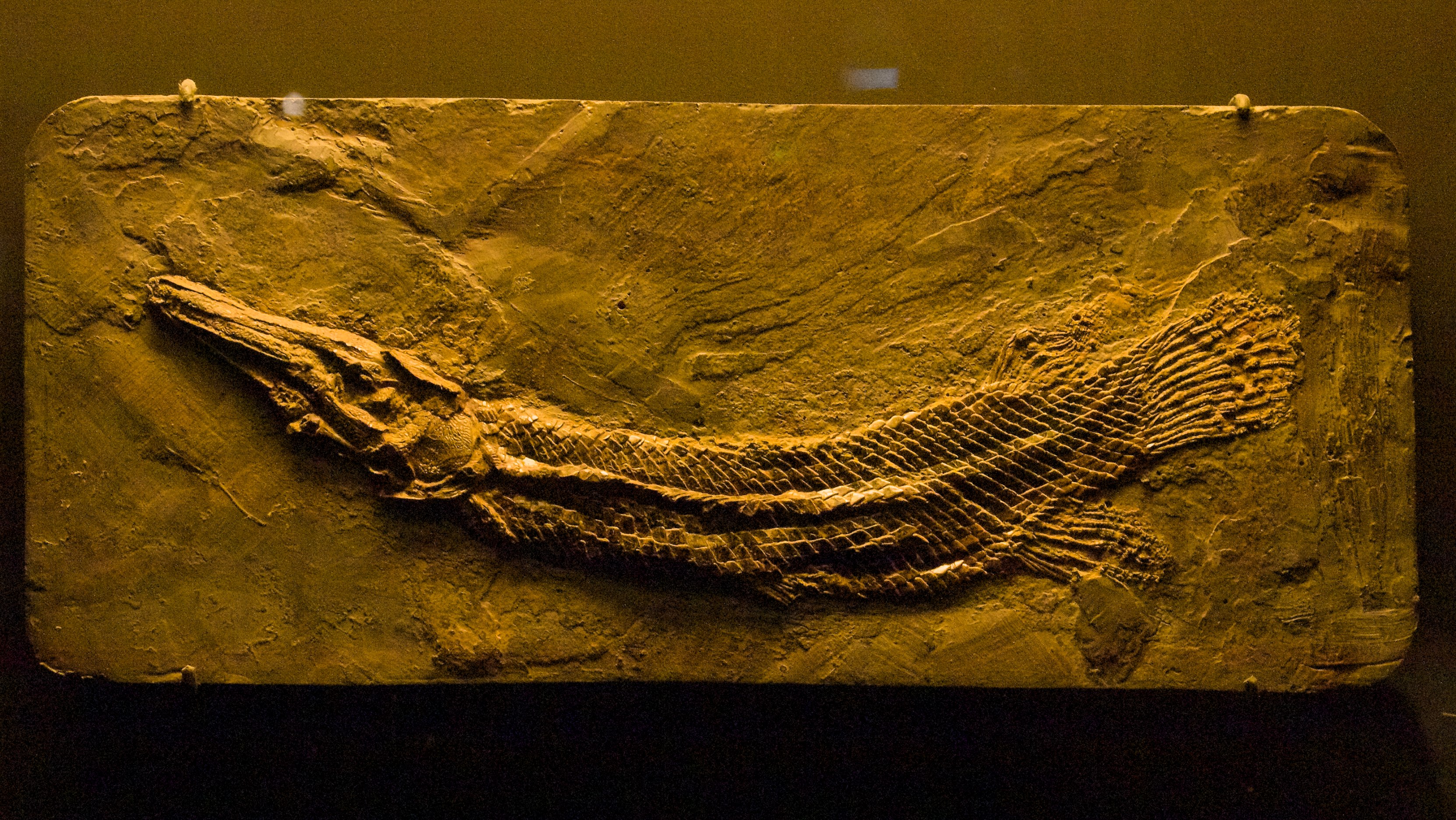|
Lepisosteiformes
Lepisosteiformes is an order of ray-finned fish and the only living members of the clade Ginglymodi. Its only extant representatives are the gar (family Lepisosteidae), and it is defined as all members of Ginglymodi that are more closely related to gar than to the extinct Semionotiformes, the other major grouping of ginglymodians. They are one of two extant orders in the infraclass Holostei alongside the Amiiformes (now represented by only the bowfins). While represented only by the two extant genera of gar from North America, the Lepisosteiformes are an ancient group known as far back as the Early Jurassic, and formerly had a much larger range, being known from almost every continent. Considerable morphological diversity is known among extinct members compared to modern gar, from the superficially gar-like Obaichthyidae to the semionotiform-like Lepidotidae, which were previously classified in the Semionotiformes. Evolution The earliest known lepisosteiform is the mari ... [...More Info...] [...Related Items...] OR: [Wikipedia] [Google] [Baidu] |
Ginglymodi
Ginglymodi is a clade of ray-finned fish containing modern-day gars (Lepisosteidae) and their extinct relatives (including the family (biology), family Lepidotidae) in the Order (biology), order Lepisosteiformes, the extinct orders Semionotiformes and Kyphosichthyiformes, and various other extinct taxa. Ginglymodi is one of the two major subgroups of the infraclass Holostei, the other one being Halecomorphi, which contains the bowfin and eyespot bowfin and their fossil relatives. Fossil record The fossil record of ginglymodians goes back at least to the Anisian stage (geology), stage of the Triassic period (geology), period, over 240 million years ago. ''Eosemionotus'' is one of the earliest ginglymodians. ''Acentrophorus'', another taxon from the Middle and Late Permian, and ''Paracentrophorus'' from the Early Triassic epoch (geology), epoch, could be even earlier members of the group. Ginglymodi was biodiversity, diverse and widespread during the Mesozoic era (geology), era, bu ... [...More Info...] [...Related Items...] OR: [Wikipedia] [Google] [Baidu] |
Scheenstia Maximus
''Scheenstia'' is an extinct genus of neopterygian ray-finned fish from the Late Jurassic–Early Cretaceous of Europe. Fossils have been found in both marine and freshwater environments. Most species of the genus were previously referred to the related genus ''Lepidotes'', but most Late Jurassic–Early Cretaceous species of that genus have since been re-classified as ''Scheenstia'' following detailed phylogenetic analysis. It is a member of Lepisosteiformes meaning that its closest living relatives are gars. The teeth of ''Scheenstia'' are low and rounded, and were likely used for crushing hard shelled organisms (durophagy). The teeth were replaced synchronously, undergoing a 180 degree rotation during development, unique among vertebrates. It was probably a relatively slow swimmer that was capable of making fine movements in order to remove prey from the seafloor. One species, the marine ''Scheenstia maximus'' from the Late Jurassic of Germany, could reach body lengths in exces ... [...More Info...] [...Related Items...] OR: [Wikipedia] [Google] [Baidu] |
Holostei
Holostei is a group of ray-finned bony fish. It is divided into two major clades, the Halecomorphi, represented by the single living genus, '' Amia'' with two species, the bowfins (''Amia calva'' and '' Amia ocellicauda''), as well as the Ginglymodi, the sole living representatives being the gars (Lepisosteidae), represented by seven living species in two genera ('' Atractosteus'', '' Lepisosteus''). The earliest members of the clade, which are putative " semionotiforms" such as '' Acentrophorus'' and '' Archaeolepidotus'', are known from the Middle to Late Permian and are among the earliest known neopterygians. Holostei was thought to be regarded as paraphyletic. However, a recent study provided evidence that the Holostei are the closest living relatives of the Teleostei, both within the Neopterygii. This was found from the morphology of the Holostei, for example presence of a paired vomer. Holosteans are closer to teleosts than are the chondrosteans, the other group ... [...More Info...] [...Related Items...] OR: [Wikipedia] [Google] [Baidu] |
Lepidotidae
Lepidotidae is an extinct family of fish, known from the Jurassic and Cretaceous periods. Most species were originally assigned to the genus ''Lepidotes'' which was long considered a wastebasket taxon. Cladistic analysis has indicated that they are close relatives of gars, with both being members of the order Lepisosteiformes. Members of the family are known from both marine and freshwater environments. Their bulky body morphology and small median fins suggests that they were slow-moving fish that were capable of performing fine movements in order to grasp prey. ''Lepidotes sensu stricto'' had peg-like grasping marginal teeth and crushing palatal teeth, and is known to have consumed small crustaceans, while '' Scheenstia'' had low rounded crushing marginal teeth, indicating a durophagous diet. Taxonomy * '' Camerichthys'' * '' Isanichthys'' * ''Lepidotes ''Lepidotes'' (from , 'covered with scales') (previously known as ''Lepidotus'') is an extinct genus of Mesozoic ray-fin ... [...More Info...] [...Related Items...] OR: [Wikipedia] [Google] [Baidu] |
Obaichthyidae
Obaichthyidae (also known as "spiny gars" or "spike gars") is an extinct family of ginglymodian ray-finned fish that lived in what is now Africa, South America, and southern Europe during the Upper Cretaceous period (Aptian–Cenomanian ages). They were close relatives of the modern gars of the family Lepisosteidae, with the two groups making up the superfamily Lepisosteoidea. Though obaichthyids are generally similar to their extant relatives, they possessed a mobile maxilla along with a large posterior spine on their scales. The specializations of the skull seen in members of the family suggest that the fish were most likely feeding in a similar style to that seen in syngnathiforms, especially those specialized for pivot feeding. Though they are mostly found in fresh and brackish water deposits, obaichthyids also had a tolerance to saltwater similar to modern gars. History Even before these genera were placed into a single family, Obaichthys had been considered to be a si ... [...More Info...] [...Related Items...] OR: [Wikipedia] [Google] [Baidu] |
Actinopterygii
Actinopterygii (; ), members of which are known as ray-finned fish or actinopterygians, is a class (biology), class of Osteichthyes, bony fish that comprise over 50% of living vertebrate species. They are so called because of their lightly built fish fin, fins made of webbings of skin supported by radially extended thin bony spine (zoology), spines called ''lepidotrichia'', as opposed to the bulkier, fleshy lobed fins of the sister taxon, sister clade Sarcopterygii (lobe-finned fish). Resembling folding fans, the actinopterygian fins can easily change shape and wetted area, providing superior thrust-to-weight ratios per movement compared to sarcopterygian and chondrichthyian fins. The fin rays attach directly to the proximal or basal skeletal elements, the radials, which represent the articulation (anatomy), articulation between these fins and the internal skeleton (e.g., pelvic and pectoral girdles). The vast majority of actinopterygians are teleosts. By species count, they domi ... [...More Info...] [...Related Items...] OR: [Wikipedia] [Google] [Baidu] |
Lepidotes
''Lepidotes'' (from , 'covered with scales') (previously known as ''Lepidotus'') is an extinct genus of Mesozoic ray-finned fish. It has long been considered a wastebasket taxon, characterised by "general features, such as thick rhomboid scales and, for most of the species, by semi-tritorial or strongly with dozens of species assigned to it. Fossils attributed to ''Lepidotes'' have been found in Jurassic and Cretaceous rocks worldwide. It has been argued that ''Lepidotes'' should be restricted to species closely related to the type species ''L. gigas,'' which are only known from the Early Jurassic of Western and Central Europe, with most other species being not closely related, with other species transferred to new genera such as '' Scheenstia.'' ''Lepidotes'' belongs to Ginglymodi, a clade of fish whose only living representatives are the gars (Lepisosteidae). The type species ''L. gigas'' and close relatives are thought to be members of the family Lepidotidae, part of the ord ... [...More Info...] [...Related Items...] OR: [Wikipedia] [Google] [Baidu] |
Bowfin
The ruddy bowfin (''Amia calva'') is a ray-finned fish native to North America. Common names include mudfish, mud pike, dogfish, grindle, grinnel, swamp trout, and choupique. It is regarded as a relict, being one of only two surviving species of the Halecomorphi, a group of fish that first appeared during the Early Triassic, around 250 million years ago. The bowfin is often considered a "living fossil" because they have retained some morphological characteristics of their early ancestors. It is one of two species in the genus ''Amia,'' along with '' Amia ocellicauda'', the eyespot bowfin. The closest living relatives of bowfins are gars, with the two groups being united in the clade Holostei. Bowfins are demersal freshwater piscivores, commonly found throughout much of the eastern United States, and in southern Ontario and Quebec. Fossil deposits indicate Amiiformes were once widespread in both freshwater and marine environments across North and South America, Europe, ... [...More Info...] [...Related Items...] OR: [Wikipedia] [Google] [Baidu] |
Lepisosteidae
Gars are an ancient group of ray-finned fish in the Family (biology), family Lepisosteidae. They comprise seven living species of fish in two genera that inhabit Fresh water, fresh, Brackish water, brackish, and occasionally marine waters of eastern North America, Central America and Cuba in the Caribbean, though extinct members of the family were more widespread. They are the only surviving members of the Ginglymodi, a clade of fish which first appeared during the Triassic period, over 240 million years ago, and are one of only two surviving groups of holosteian fish, alongside the bowfins, which have a similar distribution. Gars have elongated bodies that are heavily armored with ganoid scales, and fronted by similarly elongated jaws filled with long, sharp teeth. Gars are sometimes referred to as "garpike", but are not closely related to pike (fish), pike, which are in the fish family Esocidae. All of the gars are relatively large fish, but the alligator gar (''Atractost ... [...More Info...] [...Related Items...] OR: [Wikipedia] [Google] [Baidu] |
Laos
Laos, officially the Lao People's Democratic Republic (LPDR), is the only landlocked country in Southeast Asia. It is bordered by Myanmar and China to the northwest, Vietnam to the east, Cambodia to the southeast, and Thailand to the west and southwest. The country has a population of approximately eight million. Its Capital city, capital and most populous city is Vientiane. The country is characterized by mountainous terrain, Buddhist temples, including the UNESCO's World Heritage Site of Luang Prabang, and French colonial architecture. The country traces its historic and cultural identity to Lan Xang, a kingdom which existed from the 13th to 18th centuries. Through its location, the kingdom was a hub for overland trade. In 1707, Lan Xang split into three kingdoms: Kingdom of Luang Phrabang, Luang Prabang, Kingdom of Vientiane, Vientiane, and Kingdom of Champasak, Champasak. In 1893, these kingdoms were unified under French protection as part of French Indochina. Laos was und ... [...More Info...] [...Related Items...] OR: [Wikipedia] [Google] [Baidu] |




